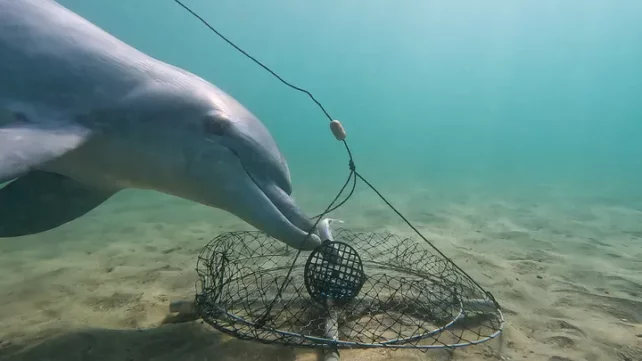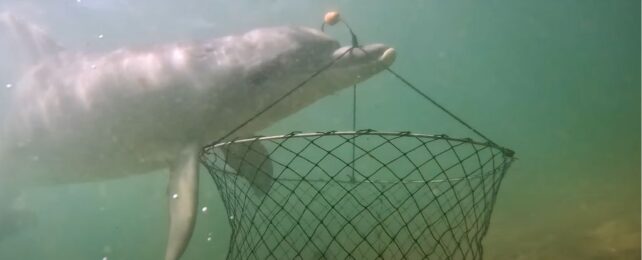Underwater cameras have captured a unique dolphin behavior off the coast of Western Australia in what scientists suspect is a world-first.
For decades now, bottlenose dolphins (Tursiops aduncus) and local crabbers in the Bunbury area, roughly 160 kilometers south of Perth, have been locked in a battle over bait.
When a crab pot is dropped in Koombana Bay, the local dolphins swoop in to snag the dead fish, usually before any pincered arthropods can come crawling along.
When wildlife conservationist Rodney Peterson heard of the problem, he feared for the dolphins' safety, given the risks of net entanglement.
Peterson approached the Dolphin Discovery Center in Bunbury – a non-profit organization that funds education, research, and ecotourism projects – about the possibility of filming the thieves in action.
Over two years, a team of filmmakers, conservationists, and researchers put their heads together to reveal "the secrets of the crab bait thieves" in Koombana Bay.
Under the turquoise waves and on the sandy seafloor, local dolphins were caught on camera using their long snouts, jaws, and teeth to pull bait out of crab pots.

Even when bait was attached underneath the pots or tucked away in boxes, it didn't take long for the dolphins to start flipping the traps over or opening the latched boxes.
"We were stunned by what we saw," reads the Dolphin Discovery Center's caption posted along with the video on their social media, "and so were researchers Dr Simon Allen and Dr Delphine Chabanne."
Chabanne, who studies animal ecology and behavior at Murdoch University, and Allen, a dolphin behavior specialist, both say they've never seen this kind of behavior in such great detail.

Dolphins around the world are known to steal fish and bait from trawlers and recreational anglers.
In Florida, for instance, bottlenose dolphins have also been cataloged in the past stealing bait from crabbers by tipping over pots.
But the interactions between dolphins and crabbers in Koombana Bay are uniquely complex, according to experts.
The physical and mental problem-solving at play is truly impressive.
Axel Grossmann, a volunteer filmmaker on the project, told Live Science that because only some dolphins partake in the behavior, stealing crab bait may be more for 'fun' or 'convenience' than for reasons of hunger.
Two dolphins, in particular, seem to be leading the clever gang of bait thieves: a mother and her calf.
"Calypso and Reggae, yeah, if it wasn't for those two, crabbing would be pretty simple, really," laughs Peterson in an explainer video shared by the Dolphin Discovery Center.
Peterson and others are concerned that these dolphins are too clever for their own good. If the behavior continues to develop and spread, it may have more downsides than upsides for the local population.
The crab bait that the dolphins are stealing is not all that nutritious and the risk of getting entangled or hurt by gear is high, especially as crabbers wrap their bait in more intricate ways.
Luckily, researchers working in Western Australia have figured out a method that seems to be 'dolphin-safe', at least for the moment.
"The bait is placed inside a strong mesh connected to the pot by metal hook," explains the Dolphin Discovery Center.
"The animals scan the pot with echolocation and eyesight, learn it cannot be opened, and swim off. Leaving healthier dolphins, happy crabbers, and proof that coexistence can work."
Hopefully that will stop Calypso and Reggae for good.
